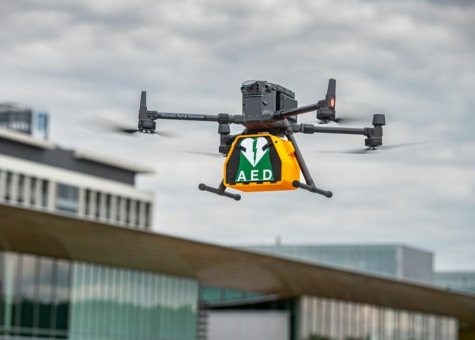Use of AED drones to increase significantly

In the event of a cardiac arrest, time is critical. The sooner rescuers begin CPR, the greater the chance of survival. Often patients in rural areas face longer wait times for ambulances to arrive. In these cases, using drones to deploy defibrillators (AED) to the location could be the way forward. Drones can shorten the wait time for an AED, tripling a patient's chances of survival.
What is an AED drone?
A drone is an unmanned-radio-controlled aircraft (see photo). What makes a drone unique is that it has many applications. For example, recently, some drones have an AEDs installed as part of their application. Once the drone has the coordinates where a medical emergency is taking place, it is sent into the air after approval from the control centre, after which the drone flies autonomously to the accident. There, the drone lowers the AED on a cord. Furthermore, the drones fly at an average of 120 kilometres per hour, and regardless of the location, the AED drone can be on site within four to seven minutes. The drone can be easily operated, even by non-medical professionals, making it a helpful addition to the existing chain of survival.
German developments in the field of AED drones
HORYZN, a German-based company, has set up the project "Mission Pulse" in cooperation with the Bayern Rode Kruis. In the event of a cardiac arrest, it currently takes an average of eleven minutes for emergency responders in Germany to arrive at the scene. HORYZN have designed a drone that can transport an AED by linear distance to the patient. Their prototype can reach patients within a 6 km radius in 5 minutes. The drone is flight-controlled via a control centre. Under video surveillance, the AED will be delivered to an emergency to be used by first responders.
2 minutes faster to an emergency in Norway, Sweden, and northern Denmark thanks to AED drones
Everdrone is a company operating in Sweden and Norway that has already deployed AED drones in emergencies. Everdrone's AED drone has led to successful resuscitation, a first in global medical history. Their revolutionary technology helped a 71-year-old Swedish patient survive cardiac arrest. The drone reached the patient an average of two minutes faster than an ambulance.
As a result, Everdrone has recently started operating in Denmark in cooperation with the Northern Denmark region, the emergency services, and the Karolinska Institute. Currently, their drones are deployed only in the city of Aalborg in cardiac arrest emergencies. In recent years, the chance of surviving a cardiac arrest in Denmark has increased significantly to around 15%. According to Pia Buus Pinstrup, chairman of the regional committee for local health care, quick help and an accessible defibrillator are essential. As a result, AED drones are already operational in this area.
Can we expect more AED drones in Europe?
This year, HORYZN plans to get the necessary certificates from the European aviation authorities to make it possible to legally station hundreds of drones in hard-to-access areas